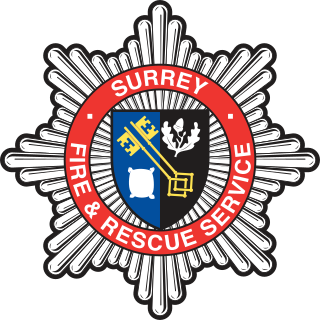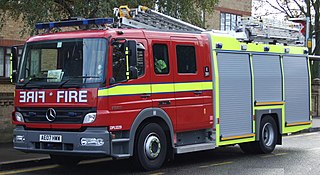
Heathrow Airport, called London Airport until 1966 and now known as London Heathrow, is a major international airport in London, England. It is the largest of the six international airports serving Greater London. The airport facility is owned and operated by Heathrow Airport Holdings. In 2021, it was the seventh-busiest airport in the world by international passenger traffic and eighth-busiest in Europe by total passenger traffic.

Wyvill Richard Nicolls Raynsford, known as Nick Raynsford, is a British politician who served as a government minister from 1997 to 2005. A member of the Labour Party, he was Member of Parliament (MP) for Greenwich and Woolwich, formerly Greenwich, from 1992 to 2015, having previously been MP for Fulham from 1986 to 1987.

Business continuity may be defined as "the capability of an organization to continue the delivery of products or services at pre-defined acceptable levels following a disruptive incident", and business continuity planning is the process of creating systems of prevention and recovery to deal with potential threats to a company. In addition to prevention, the goal is to enable ongoing operations before and during execution of disaster recovery. Business continuity is the intended outcome of proper execution of both business continuity planning and disaster recovery.
Human decontamination is the process of removing hazardous materials from the human body, including chemicals, radioactive substances, and infectious material.
Public Safety Canada, legally incorporated as the Department of Public Safety and Emergency Preparedness (PSEPC), is the department of the Government of Canada responsible for (most) matters of public safety, emergency management, national security, and emergency preparedness in Canada.

Emergency management, also called emergency response or disaster management, is the organization and management of the resources and responsibilities for dealing with all humanitarian aspects of emergencies. The aim is to prevent and reduce the harmful effects of all hazards, including disasters.

Emergency evacuation is the urgent immediate egress or escape of people away from an area that contains an imminent threat, an ongoing threat or a hazard to lives or property.

The Civil Contingencies Act 2004 is an Act of the Parliament of the United Kingdom that makes provision about civil contingencies. It also replaces former Civil Defence and Emergency Powers legislation of the 20th century.
On September 11, 2001, the North American Aerospace Defense Command (NORAD) was involved in an ongoing operation which involved deploying fighter aircraft to northeastern North America. The U.S. Military and NORAD had also planned to conduct several military exercises and a drill was being held by the National Reconnaissance Office, a Department of Defense agency. The operations, exercises and drills were all canceled following the September 11 attacks.

The disaster recovery response to Hurricane Katrina in late 2005 included U.S. federal government agencies such as the Federal Emergency Management Agency (FEMA), the United States Coast Guard (USCG), state and local-level agencies, federal and National Guard soldiers, non-governmental organizations, charities, and private individuals. Tens of thousands of volunteers and troops responded or were deployed to the disaster; most in the affected area but also throughout the U.S. at shelters set up in at least 19 states.
Hurricane Katrina had many social effects, due the significant loss and disruption of lives it caused. The number of fatalities, direct and indirect, related to Katrina is 1,833 and over 400,000 people were left homeless. The hurricane left hundreds of thousands of people without access to their homes or jobs, it separated people from relatives, and caused both physical and mental distress on those who suffered through the storm and its aftermath, such as Post-traumatic stress disorder (PTSD).

The Surrey Fire and Rescue Service is the statutory fire and rescue service for the County of Surrey, England, with 25 fire stations. It comes under the administrative and legislative control of Surrey County Council, acting as the Fire Authority who fund the service by collecting a precept via council tax, and from central government funds, known as a grant settlement, and provide the political leadership for the service.

The fire services in the United Kingdom operate under separate legislative and administrative arrangements in England and Wales, Northern Ireland, and Scotland.
The Aviation Policing Command (APC) now renamed as Aviation Security Operational Unit (SO18) is a Specialist Operations unit of London's Metropolitan Police Service. The unit is responsible for providing policing and security for both Heathrow and London City airports. London's other airports, Gatwick, Stansted and Luton are policed by Sussex, Essex, and Bedfordshire Police respectively, as they are not located in the Metropolitan Police District.

Heathrow Airtrack was a proposed railway link in the United Kingdom which would link Heathrow Airport in west London to London Waterloo railway station in Central London.
Operation Chico was a Civil Defense exercise conducted December 6-7, 1958 which consisted of a strategic evacuation of approximately 500 families from Solano County, California to the city of Chico, California and overnight care for the evacuees. The purpose of Operation Chico was to test protection measures against atomic bomb fallout and other major disasters.

Hurricane evacuation is the immediate and rapid movement of people away from the threat or actual occurrence of a hurricane. County judges, emergency managers and other officials may recommend a voluntary evacuation or order a mandatory evacuation.
Emergency planning in Wales is carried out in line with the Civil Contingencies Act 2004 however as a result of devolution it is managed with its own ‘welsh flavour.’ For instance there are unique bodies operating in Wales like The Joint Emergency Services Group (JESG) and there is involvement from The Welsh Government.
Many countries around the world have civil defense organizations dedicated to protecting civilians from military attacks and providing rescue services after widespread disasters. In most countries, civil defense is a government-managed and often volunteer-staffed organization.

The COVID-19 pandemic coincided with record-breaking wildfires in the western United States and a record number of hurricane landfalls in the southeastern United States. Emergency evacuation may be required for people living in areas threatened by natural disasters. Historic procedures maximizing capacity of public transport and emergency shelters may be inconsistent with quarantine and physical distancing measures related to the COVID-19 pandemic. It is not advisable to set up congregate shelters in an environment heavily impacted by a pandemic. Non-congregate shelters typically provide more effective physical distancing. Examples include buildings with single room occupancy, hotels or dormitories with private sleeping spaces but possibly shared bathroom or cooking facilities. Thousands of evacuees from Hurricane Laura were still in emergency lodgings as Hurricane Delta approached the Louisiana coast. Six-thousand from southwest Louisiana were in twelve New Orleans area hotels. Three-thousand-five-hundred remained in shelters as Hurricane Zeta approached Louisiana. A volcanic eruption on the island of Saint Vincent in April 2021 caused evacuation of sixteen-thousand people. Four-thousand evacuees were placed in eighty-nine government shelters after being tested for COVID-19, with those testing positive taken to isolation centers. Six-thousand evacuees found shelter in private homes.